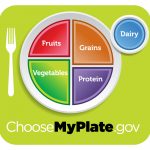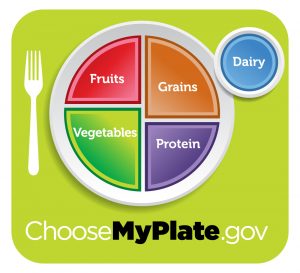Bulletin #4396, Eating for Health with MyPlate: Smart Snacking
Prepared by Extension Educator Kate Yerxa and Extension Specialist Leslie Forstadt, University of Maine Cooperative Extension. Reviewed by Extension Educator Alan Majka, University of Maine Cooperative Extension.
For information about UMaine Extension programs and resources, visit extension.umaine.edu.
Find more of our publications and books at extension.umaine.edu/publications/.
Like most Americans, Mainers eat too much fat, sugar, sodium, and refined grains. These Eating for Health with MyPlate fact sheets can start you down the path to good health. Each one is about a different part of the 2020-2025 Dietary Guidelines for Americans and MyPlate healthy eating guidelines. You can learn what each part is, why it’s important, and how it matters to you and to your family. The MyPlate food groups are Grains, Vegetables, Fruits, Dairy, and Protein. This fact sheet explains the Dairy Group.
What are snacks?
Snacks are foods that you eat between meals. Snacks can be single foods. Or, snacks can be mini-meals.
Why do people eat snacks?
Sometimes people eat snacks because they are hungry. Other times, people eat snacks because they are bored. Good snacks can help people—especially children—meet their energy and nutrient needs each day.
Tips for healthy snacks
Snacks can be part of a healthy diet. Try these snack options:
- Many fruits and vegetables come in their own wrappers. These are easy to eat on the go.
- Fruit and vegetable snacks give you important vitamins and minerals. Fruits and vegetables don’t have added fats and sugars, or too many calories. And they still fill you up.
- Plan ahead and include snacks in your meal plan. Take a healthy snack with you when you leave the house for the day. This can help you make smart snack choices. Otherwise, you may get hungry and stop at a convenience store. These stores don’t have many healthy snack choices.
- Bring your own snack with you when you travel. This will save you money, too.
Find healthy options for the kinds of snacks you usually like to eat:
| Instead of | Choose |
|---|---|
| Potato chips | Pretzels or rice cakes |
| French fries | Raw vegetables |
| Ice cream | Fat-free or low-fat milk choices (try yogurt, or chocolate- or strawberry-flavored milk) |
| Chocolate cookies | Low-fat granola bar |
| Soda | Water |
Kid-friendly snacks
Children can’t always get enough nutrients from three meals a day. Snacks are part of meal planning. This means that you should plan snacks between meals as needed for your children.
One way to plan snacks is to make snacks that include at least two food groups. Some examples are
- an apple with peanut butter (or other nut butter),
- low-fat cheese slices with crackers and pear slices,
- green beans or other fresh vegetables with hummus,
- cottage cheese with pineapple, or
- string cheese with an apple.
Water, 100% fruit juice, or milk can be served with snacks. But go easy on juice, even if it’s 100% juice. Offer whole fruit and water instead of juice.
Avoid juice drinks, cookies, and chips, because they often have a lot of fat and/or sugar. The best snacks are not pre-packaged or pre-made. Stick to fruits and vegetables, or things made from whole grains. Kids may be more likely to try fresh vegetables if they can dip them in dressings (non-fat or low-fat).
Eat healthy fats. Foods with healthy fats include natural peanut butter (the kind you have to stir the oil back into). Use plant oils like olive or canola oil when cooking, instead of butter.
How to build a healthy plate
Balance calories
- Enjoy your food, but eat less.
- Avoid oversized portions.
Eat more of . . .
- Make half your plate fruits and vegetables.
- Make half your grains whole.
- Switch to fat-free or low-fat (1%) milk.
Eat less of . . .
- Compare sodium in foods like soup, bread, and frozen meals. Choose the foods with lower numbers.
- Drink water instead of sugary drinks.
Sources
U.S. Department of Agriculture and U.S. Department of Health and Human Services. Dietary Guidelines for Americans, 2020-2025. 9th Edition. December 2020. Available at DietaryGuidelines.gov.
U.S. Department of Agriculture. MyPlate website. 2021. https://www.myplate.gov

Information in this publication is provided purely for educational purposes. No responsibility is assumed for any problems associated with the use of products or services mentioned. No endorsement of products or companies is intended, nor is criticism of unnamed products or companies implied.
© 2011, 2017, 2021
Call 800.287.0274 (in Maine), or 207.581.3188, for information on publications and program offerings from University of Maine Cooperative Extension, or visit extension.umaine.edu.
In complying with the letter and spirit of applicable laws and pursuing its own goals of diversity, the University of Maine System does not discriminate on the grounds of race, color, religion, sex, sexual orientation, transgender status, gender, gender identity or expression, ethnicity, national origin, citizenship status, familial status, ancestry, age, disability physical or mental, genetic information, or veterans or military status in employment, education, and all other programs and activities. The University provides reasonable accommodations to qualified individuals with disabilities upon request. The following person has been designated to handle inquiries regarding non-discrimination policies: Director of Institutional Equity and Title IX Services, 5713 Chadbourne Hall, Room 412, University of Maine, Orono, ME 04469-5713, 207.581.1226, TTY 711 (Maine Relay System).


